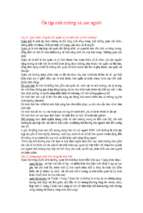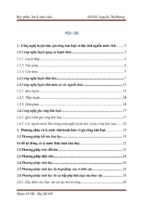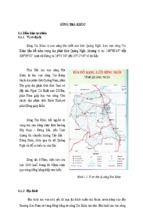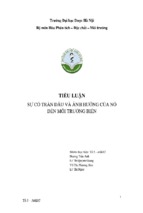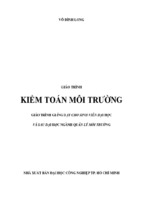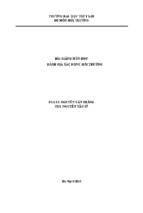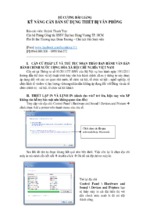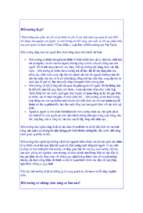RESEARCH SERIES No. 114
DETERMINANTS OF HOUSEHOLD’S
CHOICE OF COOKING ENERGY IN UGANDA
FRANCIS MWAURA
GEOFREY OKOBOI
GEMMA AHAIBWE
APRIL 2014
RESEARCH SERIES No. 114
DETERMINANTS OF HOUSEHOLD’S
CHOICE OF COOKING ENERGY IN
UGANDA
FRANCIS MWAURA
GEOFREY OKOBOI
GEMMA AHAIBWE
APRIL 2014
Copyright © Economic Policy Research Centre (EPRC)
The Economic Policy Research Centre (EPRC) is an autonomous not-for-profit organization established in 1993
with a mission to foster sustainable growth and development in Uganda through advancement of research –
based knowledge and policy analysis. Since its inception, the EPRC has made significant contributions to national
and regional policy formulation and implementation in the Republic of Uganda and throughout East Africa. The
Centre has also contributed to national and international development processes through intellectual policy
discourse and capacity strengthening for policy analysis, design and management. The EPRC envisions itself
as a Centre of excellence that is capable of maintaining a competitive edge in providing national leadership in
intellectual economic policy discourse, through timely research-based contribution to policy processes.
Disclaimer: The views expressed in this publication are those of the authors and do not necessarily represent the
views of the Economic Policy Research Centre (EPRC) or its management.
Any enquiries can be addressed in writing to the Executive Director on the following address:
Economic Policy Research Centre
Plot 51, Pool Road, Makerere University Campus
P.O. Box 7841, Kampala, Uganda
Tel: +256-414-541023/4
Fax: +256-414-541022
Email:
[email protected]
Web: www.eprc.or.ug
Determinants of Household’s Choice of Cooking Energy in Uganda
ABSTRACT
High dependency on biomass has been associated with energy poverty in Uganda with successful intervention to modern energy expected to results to economic transformation. This
paper examines utilization of various forms of cooking energy sources among households
using data from the 2005/6 Uganda National Household Survey (UNHS). Results indicate
that utilization of modern energy sources was only by 4 percent of households. A multinomial probit model (MNP) was used to estimate coefficient of determinants of energy choices.
Determinants of household energy choices were observed as consumption expenditure welfare, residing in urban or rural areas, household size, achievement of education levels beyond primary level and regional location of a household. The study recommended deliberate
efforts by government to intervene in addressing low adoption of modern energy especially
now that the country has oil and gas reserves. The government should implement policies
to encourage private sector involvement in provision of modern energy alternatives, provision of micro-credit for buying equipments and availing modern energy in smaller quantities.
Economic Policy Research Centre - EPRC
i
Determinants of Household’s Choice of Cooking Energy in Uganda
TABLE OF CONTENTS
ABSTRACT i
1.0 INTRODUCTION
1
1.1 Policy Question and Objectives
3
2.0 LITERATURE REVIEW
3
3.0 DATA AND METHODS
6
3.1 The Data
6
3.2 Conceptual framework
6
3.3 Analytical Model
8
3.4 Model specification testing issues
9
3.5 Descriptions of variables used in the analysis:
9
4.0 RESULTS
11
41. Descriptive results
11
4.2 Analytical Results
14
5.0 CONCLUSION AND POLICY IMPLICATIONS
16
5.1 Conclusions
16
5.2 Policy Implications
16
6.0 REFERENCES
17
7.0 Appendix
20
EPRC RESEARCH SERIES
21
ii
Economic Policy Research Centre - EPRC
Determinants of Household’s Choice of Cooking Energy in Uganda
1.0 INTRODUCTION
Energy poverty is one of the factors contributing to slowing down economic and socialtransformation in Uganda (GoU, 2010). Energy poverty is defined as the absence of
sufficient choice in accessing adequate, affordable, reliable, quality, safe, and environmentally benign energy services to support
economic and human development (MEMD,
2002a). The energy exploitation and consumption patterns reflect that the country
is still in infancy stages of energy application
in production processes. The exploitation
patterns are such that biomass accounts
for 92 percent of total energy consumed
while fossil fuels accounts for 7 percent and
electricity only 1 percent. Most of biomass
energy is from wood, which is consumed in
the form of charcoal and firewood (NEMA,
2009).
Schirnding et al. 2002). One of the most
profound environmental issues affecting Uganda is high rate of deforestation
(NEMA, 2009). Yet, forests play important
roles including climate moderation, carbon
sequestration, influencing the rainfall patterns, flooding control, absorption of pollutants, biodiversity conservation and other
ecosystem services such as provision of
food, medicine and spiritual purposes (NFA,
2004). Utilization of agricultural waste as
fuel aggravates the soil fertility depletion
which is associated with high cost especially
for replacement of organic matter (Sanginga and Woomer, 2009). Loss of biodiversity
affects the aesthetic, existence and bequest
value that are important for tourism industry (NEMA, 2009). Low or non-use of clean
energy may result to negative environmental effects that have negative impacts on key
productive sectors including forestry, agriculture, tourism and water (GoU, 2010).
Biomass exploitation is unsustainable due to
heavy reliance of natural forests, limitation
to its application and serious environmental effects (GoU, 2010). The rural – urban
per capita consumption has been estimated
at 680 kg per year and 240 kg per year for
firewood and 4 kg and 120 kg for charcoal
respectively (MEMD, 2007). Promotion of
efficient use of energy and mitigation of the
adverse environmental and health effects
associated with the use of biomass fuels is
an important policy issue for the country.
Alternatives to biomass energy sources include electricity, liquidified petroleum gas
(PLG) and kerosene, all of which are considered cleaner sources (Modi et. al. 2006).
Globally about 1.3 million deaths per year
are attributed to indoor pollution from biomass energy utilization (OECD/IEA, 2006).
The deaths are more than those of malaria estimated at 1.2 million per annum. In
Uganda pollution related diseases including
upper and lower respiratory account for the
second highest incidence of reported health
issues after malaria (Nabulo and Cole, 2011).
Other health issues that have been linked
to indoor pollution exposure in developing
countries include cancer, tuberculosis, perinatal mortality, low birth weights and eye
irritation and cataract (von Schirnding et al.
2002).
Utilization of biomass has been observed
to result to negative environmental, social (health) and economic impacts among
the poor in the developing countries (von
A number of interventions have been undertaken for the energy sector in the last
few years. In 2002, a National Energy Policy was produced with a goal “to meet the
Economic Policy Research Centre - EPRC
1
Determinants of Household’s Choice of Cooking Energy in Uganda
energy needs of Uganda’s population for
social and economic development in an environmentally sustainable manner” (MEMD,
2002a). The policy was a response to the
government’s desire of a long-term planning approach to the energy sector due
to its importance to the economy. One of
the objectives of the policy was to manage
energy-related environmental impacts and
was to be achieved through promotion of
alternative sources of energy and technologies which are environmentally friendly.
In 2007, the Renewable Energy Policy for
Uganda was produced with a main goal of
increasing the use of modern renewable
energy, from the 4 percent to 61 percent of
the total energy consumption by the year
2017 (MEMD, 2007). The policy wished to
respond to some challenges associated with
renewable energy technologies in meeting
energy needs of the country. One of the
challenges was the country’s desire to fulfill
the commitment on greenhouse gas emissions reductions, under the Kyoto Protocol
and contribution to the global fight against
climate change. Efficiency in biomass energy utilization was recommended in the renewable energy policy, but so far no efforts
have been documented on the issue or intervention to reduce utilization of fuelwood.
Although the country through the Forestry
Policy and National Forest Plan strives to
increase fuel source through farm forestry,
the success of the activity are yet to be observed (NEMA, 2009). Already, supply of the
biomass fuels has been limited leading to increased prices (UBoS, 2009) and the scarcity
having impacts on the quality (nutritional
value) of food prepared among the poor
(NEMA, 2008).
Albeit the efforts by the government to en-
2
Economic Policy Research Centre - EPRC
courage use of alternative energy source
through policies, high levels of reliance on
biomass energy for cooking has persisted
(UBoS, 2010). No wonder, the country has
remained among the energy poorest in Africa and has the second least improvement
on multidimensional energy poverty index
in the continent (Nussbaumer et. al. 2012).
Natural resources management institutions have put in some effort in addressing the energy challenge by raising concern
on the higher levels of forest depletions
(NEMA, 2009; NEMA, 2008; NFA 2005). The
recommendation of the natural resources
management institutions has been to plant
more trees to replace the forest cover lost
through biomass harvesting for energy.
The efforts of replacing forest cover have
not been successful due to long durations
it takes for trees to mature and the higher
rate of deforestation to cater for energy,
timber and expansion of agricultural land
(NFA, 2005). Figure A.1 (appendix) shows
the country wood fuel utilization, country potential and net increase in biomass
(MEMD, 2002b). Both the available stock
and available yearly yields have been on
decline trends. The available stock has declined from 275 million tonnes in 1995 to
less than a million tonnes. Available yearly
yields have declined from 33 million tonnes
per year to about 15 million tonnes per annum. Consumption of woodfuel has been
on increase from 19 million tonnes to 26
million tonnes per year.
Natural resources have been depleted to
the point that they are no longer able to
provide employment, water, fuel, medicine,
spiritual and cultural services and support
other productive sectors leading to higher
levels of poverty (NEMA, 2008). A case is
Determinants of Household’s Choice of Cooking Energy in Uganda
reported in Nakasongola where community livelihoods used to rely on rangelands
through firewood and charcoal burning and
selling. Currently the same community is
experiencing challenges accessing biomass
energy sources leading to a shift to paraffin
for cooking, buying of firewood from other
places and some households although with
food are unable to afford cooking energy
leading to hunger. Such experiences as in
Nakasongola are wide spread in more districts with the entire country predicted to
encounter biomass fuel scarcity by 2014
(MEMD, 2002b).
Utilization of biomass energy has been observed to be inefficient at production, processing and use levels (Naughtons-Treves et
al. 2007; MEMD, 2002b). For example, charcoal production technologies recovery rates
in Uganda are low at between 10 and 15
percent (Kazoora, et al. 2010). NaughtonsTreves and others (2007) estimated that
the manufacturer of 50 tonnes of charcoal
from hardwood required the clearance of 1
square kilometer of forest cover.
Considering the existing biomass resources,
population growth and demand for land
for various uses, the best intervention for
addressing energy challenge may be on demand side management with more emphasis being on household shifting to cleaner
energy. Understanding the factors that influence high reliance of biomass energy as
a household cooking energy source and determining opportunities for shifting demand
from biomass to modern energy will compliment the government intervention on
the energy sector especially the supply side
management. It is important to understand
the demand side issues especially consumption patterns and factors affecting energy
choice at the household level.
1.1
Policy Question and Objectives
The policy question being addressed by this
study is “what are the interventions necessary to ameliorate households’ energy poverty in Uganda?” The objectives of the study
include: to determine factors influencing household’s choice of cooking energy
source in Uganda, to determine existence
of relationship between energy poverty and
household’s consumption expenditure welfare and to determine factors that will facilitate amelioration of energy poverty in the
country. Results of the study will provide
information that will effectively facilitate
the implementation of the energy policy
and provide a yardstick for evaluation of the
promoted and implemented energy policies
that address people’s basic needs and the
preservation of the environment.
2.0 LITERATURE REVIEW
Concerns have been raised about the high
proportion of people in developing countries relying on biomass such as fuelwood,
charcoal, agricultural waste and animal
dung to meet their energy needs for cooking
(OECD/IEA, 2006). Unsustainable harvest of
resources and energy conversion technologies inefficiency were prioritized as issues
requiring immediate intervention. The
study called for new policies to ensure shifts
to cleaner and efficient use of energy for
cooking. It recommended two complimentary approaches to improve the situation:
promoting more efficient and sustainable
use of traditional biomass and encouraging
people to switch to modern cooking fuels
and technologies with appropriate mix depending on local circumstances. The same
study observed that switching to oil-based
Economic Policy Research Centre - EPRC
3
Determinants of Household’s Choice of Cooking Energy in Uganda
fuel would not have significant impacts on
world oil demand and even when fuel costs
and emissions were considered, the household energy choices of developing countries
would not be limited by economic, climatechange or energy-security concerns.
Utilization of an energy source by a household was considered a discrete choice from
a number of other alternative supply choices arranged in order of technological sophistication whether in rural or urban areas
(Campbell et al. 2003). As the demand for or
supply of more sophisticated fuels increased,
a greater number of users made transition
from firewood and charcoal through kerosene to LPG and electricity. This transition
concept also considered as “energy ladder”
(van der Horst and Hovorka, 2008) is driven
by economic change, change in taste and
preference of energy choice, technological change on energy sources, energy carrier availability (Campbell et al., 2003) and/
or shifts in supply of energy options (Zulu,
2010) and their prices (van der Horst and
Hovorka, 2008). The sophistication of energy sourcing has impact on environment and
household health.
When households climb the energy ladder, forest resources utilization reduces as
less of firewood and charcoal are required.
Indoor and outdoor pollution that leads to
respiratory acquired diseases is reduced or
eliminated with shift to more sophisticated
sources (Mishra, 2003). The sophistication
of energy sources has been considered as
improvement of household’s or/and country’s welfare, akin to other socio-welfare
indicators that have been used to measure
the standard and quality of life (Berenger
and Verdier-Chouchane, 2007).
4
Economic Policy Research Centre - EPRC
The Millennium Development Goals (MDGs),
a United Nations initiative outlining timebound goals in areas of poverty, health,
education and environment recognized the
importance of energy welfare to achieving
most of the goals. The importance of modern energy in contributing to welfare in
terms of health, saving time and providing
opportunities for other activities (especially
for women and children), improved productivity and education achievement has motivated international donors support to energy development as part of achieving MDGs
(United Nations, 2005). Energy poverty has
been considered to undermine global development challenges including income poverty, inequality, climate change, food security,
health and education (Nussbaumer et al.,
2012). While the idea of poverty has been
widely accepted among the international
community, it has been very difficult to get
an agreement on an adequate definition of
energy poverty due to problems in dealing
with methodological and conceptual issues
in defining it (Barnes, et al., 2011).
A number of approaches have been used in
defining or establishing levels of energy poverty. Pachauri and Spreng (2004) estimated
energy poverty based on energy expenditure as a proportion of household total expenditure. Under this measure households
spending more than 10 percent of their total expenditure on energy are considered
as energy poor. Another measure that has
been used in estimating energy poverty is
by considering the energy type used and
its value in the consumption expenditure of
poor households (Foster et. al. 2000). Another measure of energy poverty considers
the physical needs of daily requirements
for cooking and lighting based on surveys
around the world and sets the minimum
Determinants of Household’s Choice of Cooking Energy in Uganda
energy need to be about 50 kgOE1 per capita per year (Modi, et al. 2006). Barnes et
al., 2011 used energy demand, income and
other factors to identify the energy poverty
line in Bangladesh and reported high consistence between the income and energy
poverty. It was observed that 46 percent of
the income non-poor were also energy nonpoor while 81 percent of energy poor were
also income poor.
Nussbaumer et al, (2012) used a multidimensional energy poverty index (MEPI) to
estimate the deprivation of access to modern energy services in Africa. MEPI captured
both the incidence and intensity of energy
poverty at various levels including regional
and country levels. Socio-economic and
market access factors influence the household choice and intensity of utilization of
various energy types, which when analyzed
provide insight on energy poverty. Narasimha, et al (2007), used micro level data covering 118,000 households to establish variation in energy use by Indian households.
They reported that a household chooses the
desired source of energy considering their
socio-economic characteristics, availability
and prices of the different energy sources.
The socio-economic characteristics that affect choice of primary source of energy include household size, income, religion, education and age of the family head and location of household whether in urban or in
rural area and region. Economic, technical,
social and traditional constraints affected
complete switching to cleaner fuels in rural
India (Joon et. al. 2009). Social factors that
affected use/ choice of fuel used included
housing characteristics, cooking behavior
and food types. Demand for biomass fuel
1
was predicted to persist if only pure transition approach based on the sophistication
of energy source were not undertaken.
The policy scenarios with either improved
financing opportunities, fuel subsidies or
a combination of both in India, suggested
that a major obstacle for the adoption of
modern fuels, especially LPG, is the high investment cost and the discount rates that
the consumers use in their energy related
decisions. According to the results, subsidy
alone may be inefficient for promoting modern fuels, as the steep upfront investment
costs are not always covered through the
subsidy. Improved financial opportunities
for the appliance investment alone would
already increase penetration of modern fuels remarkably within the population. Combined with small LPG subsidy, the whole
population might be prompted to switch to
LPG (Ekholm, et al. 2010).
An increase in the proportion of households
using wood fuel sources was reported in
Kano State in Nigeria between 2002 and
2006 against a background of supply challenges for biomass sources of energy in the
town’s vicinity due to deforestation (Maconachic, et al. 2009). Although availability
of wood was reported to have reduced between 2002 and 2006, its utilization rose by
about 40 percent by 2006. Factors that affected the choice of energy sources included, cultural factors, cost of energy source,
household size, convenience in use, health
concern, environmental consideration, food
taste attributable with specific energy use,
energy source availability and recruitment
of large number of people into energy business due to shifting returns from other enterprises.
kgOE stands for kilogramme oil equivalent. A measure of total energy
consumption (1000 kgOE=42 Giga joule)
Economic Policy Research Centre - EPRC
5
Determinants of Household’s Choice of Cooking Energy in Uganda
In Ouagadougou, Burkina Faso firewood
was the cooking energy source of choice
by 70 percent of households (Ouedraogo,
2005). Other preferred choices by households were LPG, charcoal, kerosene, electricity and other fuels which were reported
by 13, 6, 4, 1 and 7 percent respectively of
the households surveyed. Determinants of
a household’s cooking fuel choice for either
natural gas, charcoal, firewood, kerosene
and other fuels were income, frequency of
different food delicacy cooking, household
size, achievements of primary education,
age of household and religion of household
head, existence of cooking facilities (external or internal) and availability of electricity
for lighting. The coefficients of the marginal
effects of multinomial logit models for all
these factors were significant at either 1, 5
or at 10 percent significance level as determinants of household cooking energy preference. Other factors with significant coefficients of the marginal effect included sex
of household head, higher education level
achievement and ownership of the dwelling.
3.0 DATA AND METHODS
3.1
The Data
Data used in this paper are derived from the
Uganda National Household Survey 2005/6
(UNHS 2005/6) collected by Uganda Bureau
of Statistics (UBoS). In particular, the data
was derived from the socio-economic and
community modules. The survey covered
7,421 households with 42,111 individuals
and was conducted between May 2005 and
April 2006. The survey was based on a two
stage stratified random sampling design.
In the first stage, Enumeration Areas (EAs)
were selected from the four geographical
regions with probability proportional to
6
Economic Policy Research Centre - EPRC
size. The sample of EAs was selected using
the Uganda Population and Housing Census Frame for 2002. In the second stage, 10
households were randomly selected from
each of the EA using simple random sampling. The household questionnaire gathered information on socio-economic issues
affecting households and communities. Information on the type of fuel used for cooking in 2005 and retrospectively in 2001 was
collected among others. The community
module captured information on community infrastructure among others.
The data used includes the social economic
characteristics of households, types of energy used for cooking and expenditure on
energy sources used for cooking. The types
of cooking energy included in the survey
were firewood, charcoal kerosene, electricity, biogas and liquefied petroleum gas (LPG).
Information reported on use of various
energy sources in 2001 was only used descriptively due to its limitation for detailed
analysis. The analytical part of the study utilized respondent information on energy use
during the survey in 2005/2006. The energy
sources were categorized into three including firewood, charcoal and modern energy.
3.2
Conceptual framework
As shown in Figure 1, use of various energy
sources for cooking by households reflect a
ladder. Shift from one level to the other is influenced by socio-economic characteristics
of the household, supply factors and government interventions that influence price
of energy options. The use of non-processed
biomass sources of energy or firewood (i.e.
crop residue and wood fuel) illustrates energy poverty among households and is associated with the lowest scale of the ladder.
This type of energy source is associated with
Determinants of Household’s Choice of Cooking Energy in Uganda
higher levels of indoor pollution, time allocations especially by women and children
for its collection, unreliability of supply and
local environment degradation. The use of
firewood is therefore a detrimental factor in
welfare improvement and constraint to the
achievement of all the eight Millennium Development Goals (MDGs).
Although the use of charcoal has been considered among some literature as similar to
firewood due to it being biomass sourced
and the fact that it is solid (Rehfuess, et al.
2006), this study considered it as a transitional step in achieving desired energy
welfare. Charcoal is processed thereby improving its portability, reducing its pollution potent and does not constraint the
achievement of all the MDGs. All other energy sources which are non-solid and are
not biomass derived have been considered
as the desired type and hence are associated with better household welfare. This
category of energy source that include fossil fuel derived kerosene and liquidified petroleum gas (LPG) and electricity utilization
have minimal constraint in achievement of
all MDGs (Barnes, et al. 2011).
The movement of households to different
levels of the energy ladder reflects a shift
from one energy poverty level to another.
A number of factors influencing such shifts
include changes in socio-economic characteristics, changes in community characteristics as influenced by private sector actors
or government and or changes affecting energy types’ prices as a result of interactions
between demand and supply. Government
interventions could influence shifts from
one energy level to the other especially with
policies that affect access and prices of energy sources. This study is interested in establishing socio-economic factors determining household choices for cooking energy.
Figure 1. Conceptual framework of poverty –energy ladder nexus
Source: Adapted from van der Horst and Hovorka, 2008
Economic Policy Research Centre - EPRC
7
Determinants of Household’s Choice of Cooking Energy in Uganda
3.3
Analytical Model
y *ij = xi′β j + ε ij
To assess the most likely explanation(s) for
y *ij
In this equation
is the unobservable
household utilization of a particular type of
utility of alternative i as perceived by indicooking energy among the various categovidual j. x′ is a (1 x M) vector of explanatory
ries, this paper uses the multinomial probit
variables characterizing both the alternative
model (Maddala, 1983). The model was sei and the individual j. β is a (M x 1) vector
lected due to its practicability on prediction
ε
of fixed parameters and ij is a normally disof probability for multiple choices and the
tributed random error term of mean zero
fact that it has been widely used (Jumbe and
assumed to be correlated with errors asAngelsen, 2011; Jepsen, 2008). The multinosociated with the other alternatives j, j =1,
mial probit model (MNP) was chosen from
… j, j ≠ i. Where it is assumed that the εi’s
other probabilistic-choice models as the
follows a multivariate normal distribution
data used on energy choice was unordered
with covariance matrix ∑ where ∑ is not re(McFadden, 1980; Jepsen, 2008). MNP was
stricted to be a diagonal matrix. Category j is
adopted in favour of multinomial logit modchosen if У*ij is highest for j, i.e.
el (MNL) in the consideration of assumption
related to the residual. MNL assumes residuals as identically and independently distributed, while MNP consider residual as independent and normally distributed (MadThe probability to choose category j can
dala, 1983). Besides MNP takes cognizant
then be written as
that other alternative choices also influence
the outcome unlike MNL which doesn’t (Lerman and Manki, 1982).
Although MNP has been identified as constraint in computations involving evaluating multiple integrals, in this study limitation did not apply as only three alternative
outcomes were being considered (Maddala,
1983). If more than three alternatives of
outcome were being considered, then, we
could have simulated using the Monte Carlo
simulation techniques (Maddala, 1983). To
address the challenge of heteroskedasticity
which is common with cross-sectional data,
weights were incorporated in the analysis.
The theoretical framework for analyzing
household’s decisions on the choice of energy source type can be cast in a random
utility model (McFadden, 1980). The MNP
model could be simply represented as
8
Economic Policy Research Centre - EPRC
Looking at this probability it is clear that
only the differences between the
’s are
identified and hence a reference category
has to be assigned. As a consequence the
covariance matrix also reduced in its dimension from (M x M) to (M-1) x (M -1). If definition for
for l =1… (j+1), …. , M then the probability
is given by a high dimensional integral at each iteration (Weeks, 1997). We
shy away from highlighting the dimensional
matrix (Bolduc, 1999; Weeks, 1997) in this
paper considering the type of readers we
are targeting. To estimate the probability p (
=1), we make one or more draws from the
density f (
and calculate the frac-
Determinants of Household’s Choice of Cooking Energy in Uganda
tion of draws that fall into the required interval, namely,
.
In this case we estimate the equation given
by
y *ij = xi′β j + ε ij
y *ij
Where
is the probability of cooking energy source alternative (i.e. energy source
selected either from firewood, charcoal
or modern). xi′ is a vector of explanatory
variable composed of vector of household
head characteristics, household characteristics and community characteristics, β is
a vector of the parameters, while εij is the
error term. i represents individual households while j could take the value of 1, 2, or
3 depending on choice of energy. Explanatory variables used in the MNP are shown in
Table 1. In this analysis modern energy comprised the non-solid energy sources used for
cooking including electricity, kerosene, LPG,
solar and biogas.
3.4
Model specification testing issues
The proliferation of random effects is one
of the most troublesome characteristic of
the multinomial probit model. The computational challenges associated with dimensional integral have been lifted by development of the simulation-based inference
particularly the Monte Carlo integration,
yet due to the number of outcomes evaluated, MNP was effective for this study. The
specification of an error structure associated with the underlying data generating process is a key component of any (stochastic)
economic model (Weeks, 1997). In the case
of the MNP model, the importance of this
is magnified given that the impact of misspecification of the error structure filters
through to the parameters of the deterministic component of choice.
Although the specification of the stochastic
component does influence mean equation
parameters, necessitating specification testing in multinomial models, no testing have
been recommended for MNP due to its inherent complexity (Hausman and McFadden, 1984). Unavailability of specification
testing notwithstanding, researcher has adopted the MNP due to its strength than the
MNL which also require a Hausman specification test. The test statistics is based upon
the difference between the two sets of parameter estimates and relies on both being
consistent under the null. This is a particularly logical test of the MNL model since the
predominant characteristic of the model,
the independence of irrelevant alternatives
(IIA), states that the ratio of two probabilities depends only upon the attributes (and
possibly characteristics) of the two alternatives considered (Weeks, 1997).
Although the MNP model is characterized
by the intractability of probability expressions for greater than four alternatives, the
log-likelihood function has a relatively simple structure. As a consequence, once an
estimator has been found for the pseudo
true value, the Cox test statistic has a closed
form representation. Also it has been recommended of a possibility to utilize classical
methodology to compare the MNL and MNP.
Since the few proposed testing involve arbitrary decisions by the analysts, their use and
improvement are limited (Natarajan et. al.,
2000; Bolduc, 1999; Weeks, 1997).
3.5
Descriptions of variables used in
the analysis:
Household head characteristic: - Household
head characteristics considered in this study
include:- education level of household head,
marital status and sex interaction, and age
Economic Policy Research Centre - EPRC
9
Determinants of Household’s Choice of Cooking Energy in Uganda
of household head. Achievement of advanced level of education was predicted to
lead to adoption of a higher energy source
on the energy ladder. Education levels
achieved were disaggregated into categories including no formal education; some
primary; completed primary; some secondary; completed secondary and any other
post-secondary education.
Age of the household head was expected to
have inverse relationship with adoption of
an alternative higher energy source on the
energy ladder. Age captures an individual’s
life cycle and its association with influencing adoption of technologies. Age of household was categorized into those aged below
25 years, those aged 26 and above but less
than 60 years and those aged 60 years and
above.
Marital status and sex interaction was considered as an important factor that will influence choice of energy source in a household.
Categories for marital status and sex interaction were unmarried/divorced/widowed
female head, married female, unmarried/
divorced/widowed male head and married
male. Inclusion of a variable representing
missing data on education levels of household head was influenced by the fact that
leaving that information out could have biased the analysis. The variable was included
after imputing median value of education
level of household heads.
Household characteristics: - Household
characteristic considered were household
size, share of adults in the household and
household welfare proxied by consumption
expenditure. Choice of an energy alternative higher in the ladder was predicted for
households with improved welfare (high in-
10
Economic Policy Research Centre - EPRC
come or expenditure) and those with larger
proportion of family members being adults.
Since investment on cleaner energy is considered expensive household with improved
welfare were assumed have higher probability of affording modern energy. Households with many members were assumed to
be unlikely to adopt cleaner energy due to
more energy requirements and associated
costs to fulfill household demand.
Community characteristics:- Community
characteristics considered as important in
influencing choice of energy for cooking by
a household were whether the household
is located in rural or urban area, specific
region, distance to feeder roads.. Access
to different energy sources have a location
dimension with modern energy sources e.g.
electricity is well distributed in urban areas.
Regional dummies (Central, Eastern, Northern and Western) and distances to feeder
roads (infrastructure) were also considered
as explanatory variables. Also included in
the explanatory variables, was the variable
representing missing data on distance to
feeder roads. The variable was included after imputing median value of the distance to
feeder roads.
Dependent variables: the multinomial probit
model used to estimate determinants of energy choice in household allowed the concurrent use of three dependent variables.
The variables used were firewood, charcoal
and modern energy.
Determinants of Household’s Choice of Cooking Energy in Uganda
Table 1. Description of explanatory variables used in the model
Characteristics
Explanatory variables
Proportion
(%)
No formal education
18.1
Some primary
Completed primary
Some secondary
Completed secondary
Post-secondary plus
Imputed median value of education level
of household head
1=unmarried/divorced/widowed female
head, 0=Others
1=Married female, 0=Others
1=unmarried/divorced/widowed male
head, 0=Others
1=Married male, 0=Others
Household age<=25 years
Household age=(26-59) years
Household age>=60 years
41.5
14.9
13.6
5.1
6.9
0.006
SD
Household head characteristics
Education level of household
head
Education level of household
head (missing data)
Marital status
and sex interaction
Age of household head
Household characteristics
Household size
Share of adults in the house hold
Welfare
Household size
Share of adults in the household
Log of Consumption expenditure per
adult equivalent per month (Ush), real
terms
Community characteristics
Residence in urban
Region
1= urban, 0=others
Distance to feeder roads
Distance to feeder roads(missing
data)
Log of distance to the feeder roads
Imputed median value of distance to
feeder roads
41.
Descriptive results
Table 2 shows the proportion of households
using various sources of energy for cooking
in Uganda in 2005 and 2001. In 2005, fire-
8.9
8.7
64.1
12.3
71.8
15.9
Mean
5.2
0.6
10.7
2.9
0.6
0.7
Proportion (%)
22.9
1=central, 0=others
1=eastern, 0=others
1=Northern, 0=others
1=Western, 0=others
4.0 RESULTS
18.3
28.3
25.9
21.9
23.8
Mean
0.7
0.04
1.1
0.2
wood use at the national level was 76 percent of households. Charcoal use at national
level was low with about a fifth of all households. Use of modern energy was observed
to be very low nationally with only 4 percent
of household reporting its use in 2005. Use
of charcoal was dominant in urban areas
Economic Policy Research Centre - EPRC
11
Determinants of Household’s Choice of Cooking Energy in Uganda
Table 2: Trends of households’ cooking energy source preference in 2005 and 2001
(column percentages)
Urban
Energy Source 2001 2005
2001
Rural
2005
National
2001 2005
Regional, 2005
Central East
North West
Firewood
38.9
29.9
92.1
90.2
80.4
76.4
63.6
78.3
83.3
83.3
Charcoal
55.9
60.8
6.8
7.7
17.6
19.8
30.1
18.6
18.3
13.0
Modern
5.1
9.3
1.2
2.2
2.0
3.8
6.3
3.1
1.42
3.7
Total
6,761 7,389
6,761
7,389
6,761
7,389
2,088
1,920
1,623
1,758
Source: Authors calculation based on UNHS, 2005/6
(61 percent) while firewood was widely relied on in rural areas where 90 percent of
respondents reported it as the main energy
source for cooking. Use of modern energy
sources was by 2 and 9 percent in rural and
urban areas respectively.
In urban areas, the proportion of households who were using firewood progressively decreased from 39 percent in 2001 to
about 30 percent in 2005. The proportion of
urban households who were using modern
cooking energy increased from 5 to 9 percent. There was an increase in the proportion of households who were using charcoal
from 56 to 61 percent among urban dwellers between 2001 and 2005. The proportion
of rural households who used various types
of energy changed marginally between
2001 and 2005. Reliance on firewood as a
preferred choice of cooking energy source
reduced from 92 to 90 percent. In rural areas, the proportion of those who used charcoal and modern energy in 2005 increased
by about one percent from the 2001 levels.
Nationally, status of various energy sources
used changed slightly between 2001 and
2005. Proportion of households who were
using firewood decreased from 80 to 76
percent. Proportion of households utilizing
charcoal increased from 18 to 20 percent
while use of modern energy rose from 2 to
4 percent between 2001 and 2005.
12
Economic Policy Research Centre - EPRC
Energy source utilized for cooking among
households changed marginally between
2001 and 2005 indicating a little improvement of type of household’s cooking energy
adopted among Ugandans. This study’s observation is consistent with that of Nussbaumer and others (2012) which reported only
slight improvement in multidimensional
energy poverty indices (MEPI) in Uganda
over time. Although Uganda was observed
as being among the energy poorest country
in Africa together with Malawi, Rwanda, Niger and Ethiopia, the country performed the
worst in improving its population’s energy
poverty welfare.
Though firewood was the most popular
cooking energy source across the regions,
the highest percentage of households who
reported use of firewood as the main energy source were in northern and western
regions (83 percent). Only Central region reported a percentage use of firewood lower
than the national average. The percentage
of households using charcoal in the Central
was 30 percent, more than twice the percentage in the Western at 13 percent. As
expected, modern energy utilization was
highest at 6 percent in the more urbanized
Central region which has greater access to
modern sources of energy.
Determinants of Household’s Choice of Cooking Energy in Uganda
Figure 2 depicts the relationship between
household welfare (proxied by consumption expenditure) and their expenditure
on various categories of cooking energies.
The graph for household expenditure on
charcoal indicates that at lower levels of
household welfare improvement (increased
consumption expenditure to about UGX
300,000 per month), households increased
its use up to about UGX 25,000 per month.
As welfare improved expenditure on charcoal reduced while expenditure on modern
energy increased. At higher levels of welfare,
households do not expand firewood use. Expenditure on firewood remained low at less
than UGX 15,000 per month. From the graph
it is clear that there is a direct exponential
relationship between monthly expenditure
on modern energy and consumption expenditure per adult equivalent. Observations
from this graph lead to a conclusion that the
incidence and intensity of improved energy
utilization among households is influenced
by household welfare proxied by consumption expenditure.
Figure 3 shows share of total expenditure
attributed to various types of energy sources for different income quintiles. Across all
quintiles, expenditure on charcoal accounted for the largest share of spending on energy. The expenditure on firewood and modern energy accounted for the second and
third largest share respectively across all the
quintiles. While the ratio of expenditure associated with energy to the total household
expenditure decreased as one ascended to
the richer quintiles, the patterns of spending on various energy types remained identical. The ratio of expenditure attributed to
modern energy decreased as one ascended
the welfare ladder from quint1, the poorest
fifth of the households to quint5 (the richest 20 percent of the households). The ratio
of spending on various energy types to the
household’s total expenditure ranged from
3 to 11 percent.
0
Monthly expenditure
20000 40000 60000 80000 100000
Figure 2. Household income and cooking energy expenditure relationship in 2005
0
200000
400000
600000
800000
Consumption expenditure per adult equivalent, real terms
predicted firewood expenditure
predicted modern energy expenditure
predicted charcoal expenditure
Economic Policy Research Centre - EPRC
13
Determinants of Household’s Choice of Cooking Energy in Uganda
Quint1
Quint2
Quint3
Quint4
w
oo
ha d
rc
oa
M l
od
er
n
C
Fi
re
oo
ha d
rc
o
M al
od
er
n
w
C
Fi
re
oo
ha d
rc
oa
M l
od
er
n
w
C
Fi
re
w
oo
ha d
rc
o
M al
od
er
n
C
Fi
re
C
Fi
re
w
oo
ha d
rc
oa
M l
od
er
n
0
% household income spent on energy
2
4
6
8
10
Figure 3. Proportion of income spent on energy by income quintiles in 2005
Quint5
Source: Authors calculations based on UNHS 2005/06
4.2
Analytical Results
Table 2 shows marginal effects coefficients
and predicted probability of a multinomial probit estimates. Predicted probability values confirmed that most households
had very high probability (89.7 percent) of
adopting firewood for cooking. Households
with a probability of choosing charcoal as
energy source accounted for 9.7 percent
of Uganda’s households, while those that
could have a probability of choosing modern energy made up less than 1 percent of
the population.
The marginal effects of household energy
use for cooking indicate that households in
rural areas had 51 percent chances of choosing firewood than their urban counterparts.
The probability of household in urban area
adopting modern energy was about 3 percent. The probability of household in urban
area choosing charcoal was about 49 percent. Achievement of formal education by
household head to beyond completion of
14
Economic Policy Research Centre - EPRC
primary education was observed to have
increased the probabilities of households
choosing cleaner energy source.
Achievement of some secondary education
reduced the likelihood of households adopting firewood as the cooking energy source.
Completion of secondary and post–secondary plus education achievements reduced
probabilities of choosing firewood by 13
and 14 percent respectively. Being unmarried/divorced/widowed male head, share of
adults in a household, improved welfare and
a household being in the urban increased
the likelihood of households adopting modern energy.
Married females, household heads aged
above 25 years, large households and
household being in Northern region were
observed as being significant in reducing
likelihood of household choosing modern
energy as the cooking energy source. Some
factors that influenced household persistence use of firewood included;- the head of


